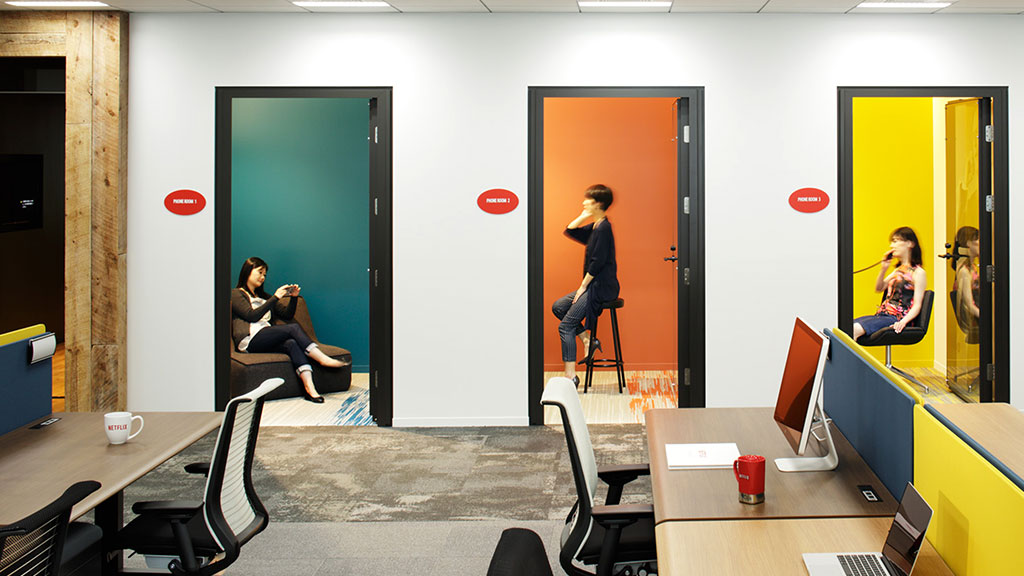Can individual work survive in the “collaborative” workplace?
Emerging Work Styles
What We Did
We conducted both primary and secondary research to understand the nature of, and challenges to, individual work with a particular focus on open-office environments. We targeted software developers as our primary study group and one comprising focus-oriented, knowledge-based workers. In partnership with a major technology company, we conducted interviews, focus groups, surveys, observational studies, and acoustic measurements to gather information about the conditions that prevent and enable individual work.
From our findings, we developed focus task typologies and work style profiles to define common work modes and areas of frustration in the workplace. We used these typologies, in light of current research on individual and collaborative work and their impacts on employee performance and experience, to develop a series of recommendations – from design strategies to behavior and cultural shifts – to improve the ability for employees to focus in the modern workplace.
The Context
As organizations become more distributed, more collaborative and more outsourced, the ways we work and connect are changing. The workplace had, and has, no choice but to evolve to meet new demands and realities. But even as companies and the workplace evolve, the ability to focus at work has never been more essential for knowledge workers and for companies looking to compete in the global marketplace. Workers who are able to focus successfully in their workplace report significantly higher levels of engagement than those who could not.
Yet the ability to complete one’s individual work is, in the minds of many, under siege in the workplace. Why? Many of today’s workspaces are often built explicitly in pursuit of collaboration, efficiency and flexibility – all top-of-mind issues for real estate managers and executives, and rightly so. At their worse, these same spaces are compromising quiet, “heads-down” work, and ultimately employee productivity. But this isn’t always the case – our prior research also shows that the right balance between focus and collaboration leads to greater innovation and higher performance overall. Understanding the behavioral, organizational and spatial requirements to achieve this balance was a driving force of our investigation.
The Results
Distraction is universal. One of the biggest challenges to effective focus work is distraction, and the primary sources of distraction in the workplace are interruptions by other co-workers and overheard conversations. These factors can be a significant detriment to workplace satisfaction, particularly when out of an employee’s control. Addressing distraction doesn’t necessarily mean making it quieter, however – developer interview results showed a marked split between those preferring quiet, private spaces and those that work better in “buzzy” environments.
One person’s distraction is another’s interaction. Noise isn’t always bad, however. Some impromptu interruptions by co-workers are highly productive in terms of overall team performance, even if they undermine a certain amount of individual performance in the process. Similarly, overheard conversations – among team members and in the right context – can speed decision-making and problem-solving on team projects.
Managing distraction requires discipline. What constitutes a distraction, and how disruptive, is variable – acceptable levels of distraction often relate more to individual preference or expectation more than the specifics of environments or noise levels. And many work process interruptions are self-imposed – upwards of 44% according to a study out of UC Irvine, noting employees’ tendency to switch tasks frequently throughout the day (and particularly those in open-plan environments).
What This Means
Support individual, team and organizational work processes. Finding effective strategies for improving people’s ability to focus in the workplace requires taking into account not only the physical environment and workplace setting, but also team dynamics, work styles and organizational culture. Workplace design must align process, culture, policy and management for employees to perform at their best.
Sometimes, group performance should trump the individual. Some distraction ultimately becomes productive interaction, and employees who work in teams know it. Help them filter out unproductive distraction and know when and how to accommodate the productive kind.
Empower employees to match process to place. Working effectively as an individual and team requires discipline and choice. Spaces and policies that support making these decisions are imperative. Employees know intuitively when they are open to interaction or distraction and when they’re not – let them communicate amongst themselves and make their own plan.
What’s Next?
Undisciplined collaboration can be a significant hindrance to individual focused work. As future work trends predict that knowledge workers will increasingly adopt agile and flexible work styles, understanding the impact of disorganized collaboration will become more valuable to our clients.
We are exploring opportunities for user autonomy in design solutions that can apply to diverse client needs. We are also studying how focus and individual effectiveness is directly impacted by team efficiency and collaborative behaviors. We believe that when the team collaborates efficiently, there are fewer distractions and interruptions in the workplace, improving the ability to focus and ultimately employee productivity.
Learn More
Team
Gervais Tompkin, Laura Mihailoff, Thomas Muchnick, Lisa Hsiao, Miriam Diaz
Year Completed
2015
Comments or ideas for further questions we should investigate?
